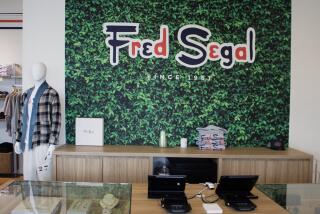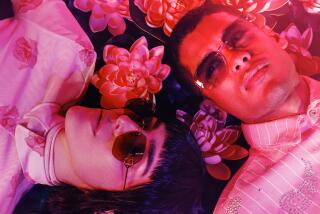Made in the Shades : Sunglass Manufacturers Try to Cash In on the Culture of Cool
America has become a sunglass culture. A society of shades, if you will.
At one time, marketers convinced us that we can make bold statements about ourselves by the brand of soda pop we drank--or the sneakers we wore. But now, it is those dark spectacles on our noses that tell all. Sunglass makers are making a killing on our mass desire to look cool.
And for all of todayâs talk about ultraviolet sun protection, consumer psychologists say that when we slip into our $275 Revos, we are mostly protecting ourselves from looking ordinary.
Just as athletic shoe makers convinced us that we need $100 tennis shoes--and a different sneaker for every sport--the sunglass industry is now spurring its own growth by persuading us that we need different sunglasses while driving the car, steering the boat or competing in the Iditarod.
âItâs all about imagery,â said Marge Axelrad, editorial director of the trade publication 20/20. âFashion and styling have never been more important.â
Nothing--absolutely nothing--sells sunglasses like style. âUltimately, you buy a pair of sunglasses because you think they look good on your face,â said Jeff Turner, general manager of Nikon Inc.âs eye wear division, which is running ads that nudge consumers to buy several pairs of its performance glasses for different activities.
This is prime sunglass season. Between Memorial Day and the Fourth of July, sunglass makers expect to peddle nearly 60% of the estimated $2.5 billion in non-prescription sunglasses that will be sold this year.
California reigns as the nationâs sunglass capital. By one estimate, nearly 25% of all sunglasses sold in 1994 will be sold in California. Although flea markets--and tourist attractions like Venice Beach--sell lots of low-end glasses for under $10, the big-ticket sunglasses for over $100 are increasingly being bought at sunglass specialty stores.
While sales of all sunglasses jumped 14.6% last year, sales of upper-end sunglasses (those over $30) were up nearly 17%, according to Bausch & Lomb. Manufacturers say that smaller, geometric metal frames are among todayâs most popular designs.
For $330, you can pick up a pair of fancy Serengeti sunglasses guaranteed to cut reflective glare from water, snow or your $120-an-hour tennis proâs metal racquet.
And if your 8-year-old needs a new set of shades--because the last pair ended up getting flushed down the toilet--Bausch & Lomb has just introduced its new âCoversâ line of sunglasses that, for $30 a pop, come with a kiddie neck cord to avoid immediate loss.
*
Sunglass industry executives concede that the current sunglass mania was carefully carved out by manufacturers--many of which pay celebrities to wear their shades. âAll of this has been greatly enhanced by marketing,â said Jim Pritts, president of the Sunglass Assn. of America.
Every time some major Hollywood hunk slips into a new pair of shades on screen, sales of the brand tend to skyrocket. Tom Cruise sent Ray-Ban sales through the roof when he wore them in âRisky Business.â Ditto for Arnold
Schwarzenegger and his too-cool Ray-Ban âBaloramasâ in âTerminator 2.â And the film âBlues Brothersâ caused a run on Ray-Banâs thick-framed âWayfarerâ sunglasses.
Jackie Kennedy Onassis made over-sized sunglasses the craze among the over-40 set for years--although few realized that her designer frames were actually prescription sunglasses.
Bausch & Lomb pays baseball slugger Frank Thomas to don its outer space-like âKiller Loopâ glasses. Oakley Inc., which virtually owns the so-called âperformanceâ segment of sunglasses, has Winter Olympic gold medalists Bonnie Blair and Dan Jansen wearing its brand. Serengeti pays A.J. Foyt to slips on its shades. And Revo has Reggie Jackson in its glasses.
Reebok has just begun trying to do with sunglasses what it did with athletic shoes. But the company finds it canât coax its big-name athletes to wear its shades because most already have deals with other companies, said Marty Blue, director of licensing. Thomas is with Bausch & Lomb, as is Olympic skater Nancy Kerrigan, who wears the companyâs Ray-Ban line.
Foster-Grant, a company that once ruled the industry, resurfaced over the weekend with its first national TV ad campaign in 15 years.
The company, which makes lower-end sunglasses (under $30 a pair), was king of the sunglass market in the 1960s and 1970s. But after years of mismanagement, it sought protection from creditors in 1988 when it filed for Chapter 11 bankruptcy. Recently, Foster-Grant was purchased by Rye, N.Y.-based Benson Eyecare Corp., which is about to spend millions to re-establish the brand.
Over Memorial Day Weekend, Foster-Grant began airing a new ad that features its 30-year-old slogan, âWhoâs that behind those Foster-Grants?â
âBrand awareness is incredibly strong,â said Ken Shaw, senior vice president of sales. Indeed, Foster-Grant tested its slogan among groups of consumers and discovered that 35- to 54-year-olds were as familiar with that line as the slogan, âLook whoâs squeezing the Charmin.â
By next year, Foster-Grant may try to introduce a line of higher-end sunglasses, Shaw said.
Cashing in on the high-end sunglass craze is the Sunglass Hut chain, which has nearly 750 stores nationwide. It will also expand into several European countries this year, said Jack B. Chadsey, president of the Coral Gables, Fla.-based chain.
âIt all boils down to lifestyle,â said Chadsey, who said the typical sunglass customer will own 30 pair of sunglasses over a lifetime. âWe all sit on our sunglasses, drop them or leave them sitting on the table in the restaurant.â
Today, the typical customer spends $77 on sunglasses at Sunglass Hut, Chadsey said. To improve its bottom line, the firm recently developed its own private-label line, SunGear.
Also trying to cut in on that action is the giant LensCrafters optical chain. In five test markets, LensCrafters is linking up with the Sunglass Hut chain by offering discounts to Sunglass Hut customers.
Behind the current sunglass craze is a simple cry for attention by many people who wear them. âItâs the upscale equivalent of the tattoo,â said psychologist Dr. Joyce Brothers. âWearing sunglasses may be the last bit of lure that we have left.â
Eyes on Growth
Bolstered by new inroads into niche marketing and a growing number of sunglass specialty stores, sales of non-prescription sunglasses in the U.S. jumped 14.6% last year and are expected to see bigger growth this year.
1993 1992 1991 1990 1989 Sales (billions) $2.12 $1.85 $1.98 $1.88 $1.71 Units (millions) 98.7 95.0 105.1 105.5 102.1 Average retail price $21.48 $19.49 $18.87 $17.82 $16.82
Source: Bausch & Lomb
More to Read
Inside the business of entertainment
The Wide Shot brings you news, analysis and insights on everything from streaming wars to production â and what it all means for the future.
You may occasionally receive promotional content from the Los Angeles Times.










